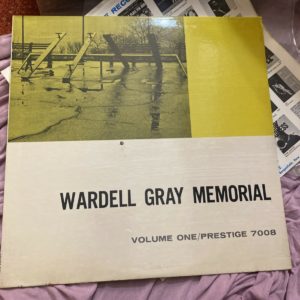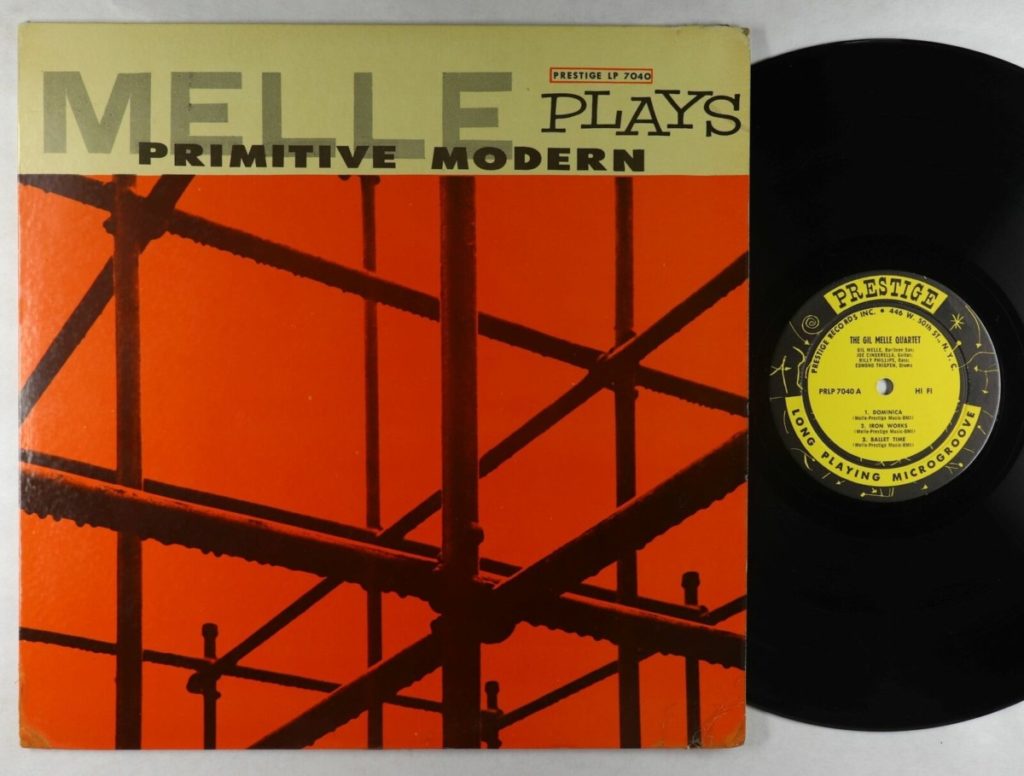Prestiges and Transitions and Booklets and Speculation
 Perusing eBay and came upon this record: Wardell Gray Memorial Album, Volume One, Prestige 7008. This is an early New York yellow label pressing with the second cover. The cover has a cutout hole in the center. The record is listed in M- condition and the cover is VG+. Start price is $350 with no bidders and plenty of time left on the auction. What strikes me about this is why Prestige changed covers so early and often in the early years. Off the top of my head, I can think of a bunch of similar situations: Sonny Rollins Plus Four, John Coltrane with the Red Garland Trio, All Day Long, all come to mind. I know the cynical answer is they did it to make money, but how? Were they also experimenting to see what would sell better? Perhaps covers with innocuous photos such as this Wardell record, versus a picture of a black artist? Perhaps a careless buyer would buy both copies? Perhaps they envisioned a time in the far off future when they could drive collectors crazy with questions like this? I have raised this question before and Rudolf has been helpful in sharing his insight. Any other thoughts?
Perusing eBay and came upon this record: Wardell Gray Memorial Album, Volume One, Prestige 7008. This is an early New York yellow label pressing with the second cover. The cover has a cutout hole in the center. The record is listed in M- condition and the cover is VG+. Start price is $350 with no bidders and plenty of time left on the auction. What strikes me about this is why Prestige changed covers so early and often in the early years. Off the top of my head, I can think of a bunch of similar situations: Sonny Rollins Plus Four, John Coltrane with the Red Garland Trio, All Day Long, all come to mind. I know the cynical answer is they did it to make money, but how? Were they also experimenting to see what would sell better? Perhaps covers with innocuous photos such as this Wardell record, versus a picture of a black artist? Perhaps a careless buyer would buy both copies? Perhaps they envisioned a time in the far off future when they could drive collectors crazy with questions like this? I have raised this question before and Rudolf has been helpful in sharing his insight. Any other thoughts?
I mentioned that the seller Carolinasoul has a lot of nice jazz records for sale now (and seemingly always), including a couple from the Transition label: Doug Watkins at Large, Transition 20. This is an original pressing with the booklet. The record and cover are both listed in VG condition and the bidding is in the $300 range with more than three days left on the auction. Donald Byrd, Byrd’s Eye View, Transition 4. This is also an original pressing with the booklet. Gotta love those original collectors who kept the booklets. This one is graded VG+ for the record and VG for the cover. Bidding is also in the $300 range. One more non-Blue Note from the same seller: Gil Melle Plays Primitive Modern, Prestige 7040. This is an original New York yellow label pressing listed in VG+ condition for both the record and the cover. Bidding is in the $200 range with more than three days left.


Isn’t it very unusual to see a cutout hole in that location? I can’t recall ever seeing one in that spot. Obviously the record was out when the hole was made, which I find odd. I’m not a seasoned collector, so
maybe it’s not as rare as I think.
You’re right, the cut-out hole is odd, even brutal, but not uncommon. I have a few Riversides with this same bullet hole, including a Bill Evans and a first-press stereo Incredible Guitar of Wes Montgomery.
I’ve also wondered about the Prestige quick-change covers. In the case of Sonny Rollins Plus Four, the 2nd cover is a Reid Miles design, and pretty nice. Was Prestige attempting to ride coattails on Blue Note’s success with Mr Miles?
It is a drill hole, as can be seen in the pics, the drill goes right through the record label. This wasn’t an uncommon practice back then.
Yes, I’ve seen that cutout hole on a lot of Riversides. Actually, the hole often goes right through the record when they do it in that spot.
That Melle has always been one of my favorite covers. Wish I had a copy!
I gather that the Wardell cover was done to capitalize on a similar design for the Clifford Brown Memorial and get people to potentially buy both, especially if the former wasn’t selling too well.
The similarity of the children’s playground design on the Clifford Brown and Wardell Gray Memorials is striking. Still, for a memorial album the playground design is an absolute misser, at least for me.
Bob Weinstock was thinking in terms of sales. When the Elmo Hope Sextet, Informal Jazz, 7043 was lagging behind, it was renamed Two Tenors, the brown sleeve with Hank Mobley the first tenor. He changed again to cash in on Trane ‘s success, and it became almost Trane ‘s album. The liners of the 2nd and 3rd versions are identical, reference to Elmo deleted.
Another Hope album which was repackaged is 7021. From a Hope album it became a Frank Foster album. The second design by an unknown artist (Reid Miles?) is really nice. Conclusion: Hope did not sell. His trio recording 7010 was quickly deleted.
The first design of 7013, Conception, is not attractive, the second by Reid Miles is.
The subject is Interesting. Many more interesting examples.
E.g. The Jon Eardly Septette, 7033, with the nice Gil Mellé made design, became Down East, a freight train, with Phil Woods and Zoot Sims the leaders. The liners have been adapted and Jon’s role deleted.
I dunno Rudolf, the empty playground theme for Wardell and Clifford is a striking visual statement, no matter what motivated the marketing strategy
Carolinasoul has over 1000 records listed wow! not to mention some pretty heave hitter Blue notes, most are in vg/vg+ condition ,i assume a lot of those are on co-signment? anyway he is going to be busy mailing all those records
I think the empty playground reference is a kind of memento mori — especially as Brownie and Wardell’s lives were both tragically cut short. I like the design myself.
I see where Art Pepper on Intro sold for $1,718. (Carolina Soul auction).